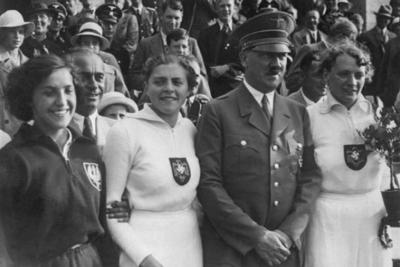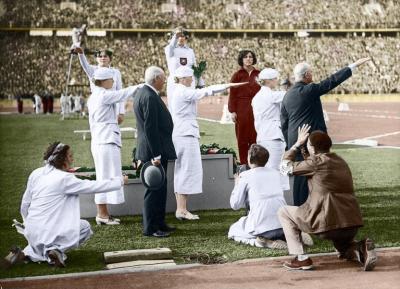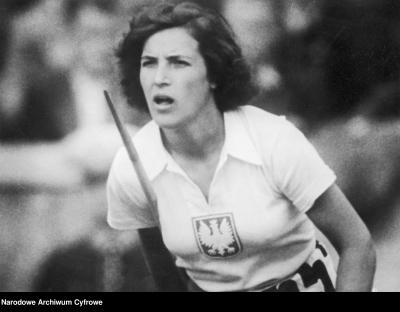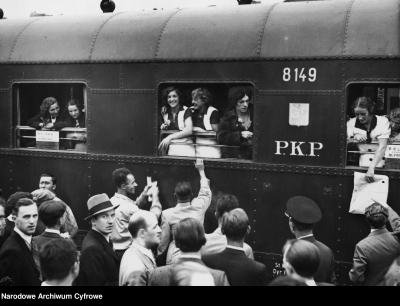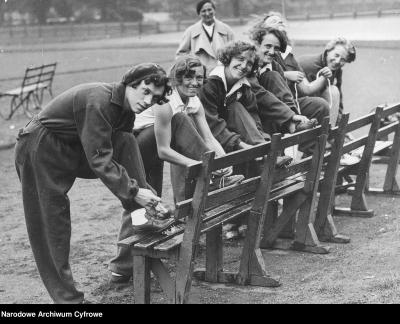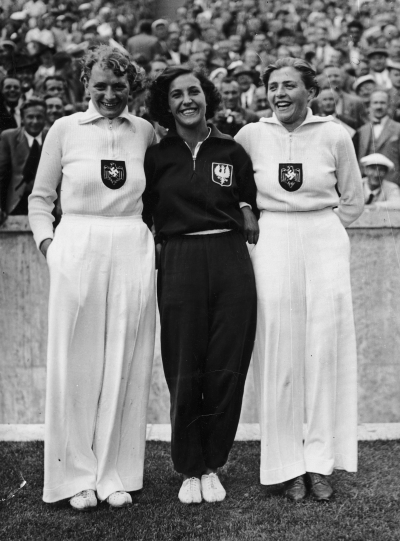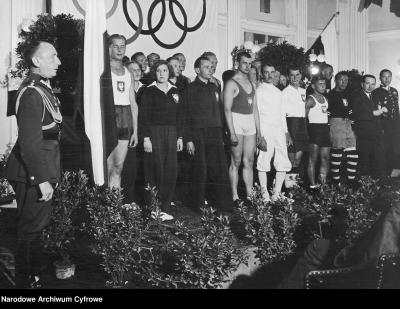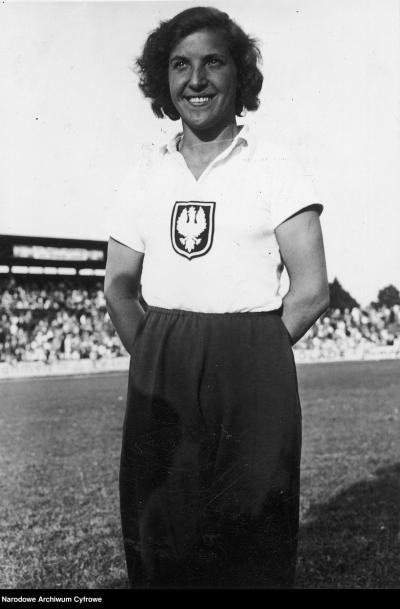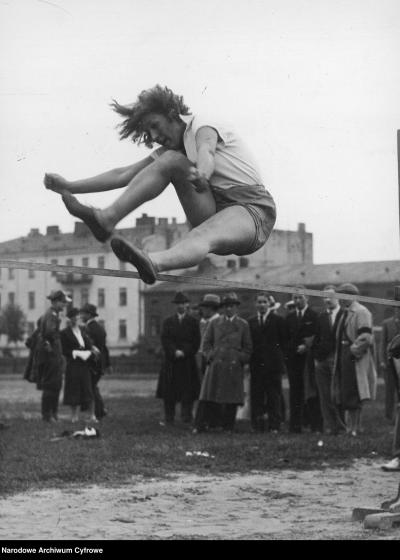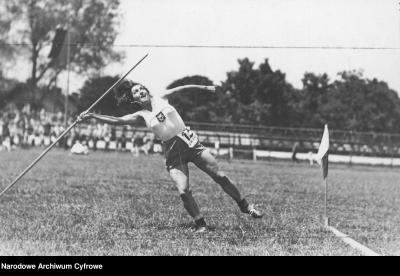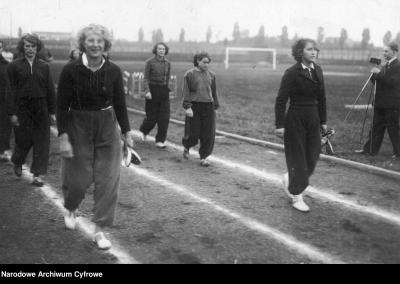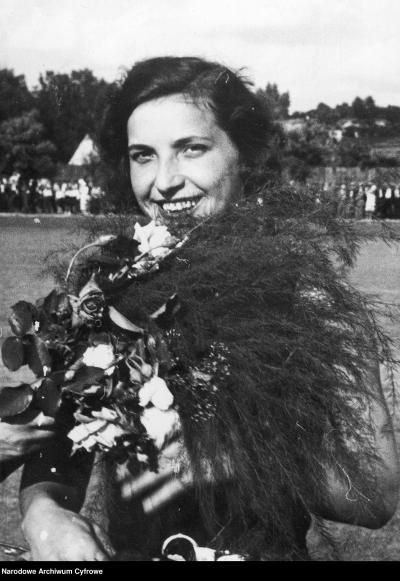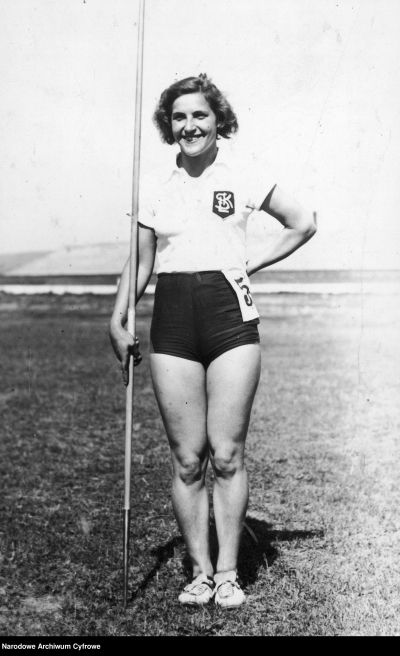Maria Kwaśniewska and the story of a photograph

The war and the return home
When the Second World War breaks out, Maria Kwaśniewska is in Genoa, Italy, where, with a grant from the Polish Athletic Association (Polski Związek Lekkiej Atletyki), she is preparing for the 1940 Olympic Games in Helsinki, which are then cancelled due to the attack on Finland by the former USSR. At this time, Kwaśniewska is one of the best athletes in the world. When she hears about Germany’s invasion of Poland, she decides to leave Italy, which at that time was still safe, and to return to Warsaw. “I entered the country against the tide, as it were. People were already talking about war, so I could also have stayed [in Italy]. Everyone tried to talk me into staying, but I didn’t want to. At the Zebrzydowice border crossing, people looked at me as if I were mad. People were leaving the country in droves and I returned to Warsaw, even if I didn’t really know with what and how I was going to do it” – This is how Maria Kwaśniewska recalled this moment in an interview which she gave to the “Rzeczpospolita” newspaper in 2000.[3]
On 2 September 1939, introduces herself to Warsaw. The year before she had completed a course to become a paramedic. She also has a driving licence. She is immediately set to work as an ambulance driver in the area around the Warsaw power station in the Wybrzeże Kościuszkowskie street and her job is to transport wounded soldiers from the trenches to the hospitals. She is awarded the cross for bravery (Krzyż Walecznych) by Stefan Starzyński, the former Mayor of the city, for her involvement in the defence of Warsaw. During the war, Maria Kwaśniewska meets her second husband, Julian Koźmiński. He is a director of the power station and commanding officer for the defence of Warsaw. But her luck doesn’t last. Koźmiński is arrested by the Gestapo and taken to the prison in Szucha allée. He was so ill when he left prison that he died shortly afterwards. Whilst he is still alive, however, the couple move to a house in Podkowa Leśna near Warsaw.
The free pass to living
In the period after their move, Kwaśniewska works non-stop for the resistance. At the beginning of August 1944, transit camp 121, also referred to as Dulag 121, is established by the Nazis. The camp is built for the civilian population of Warsaw driven from their house in the Warsaw uprising and after its suppression. Within six months, around 400,000 people are channelled through this camp. The Nazis make their selections there: those who are strong enough are assigned to forced labour, the weak, the old and the infirm are taken to concentration camps.
It is now that Maria Kwaśniewska remembers her photograph with Adolf Hitler hidden deep down in a suitcase. She takes it with her and shows it to the guards at the entrance gate to the Pruszków camp. The photograph works like a free pass. Of course, the gendarmes don’t know who Kwaśniewska is, but they don’t want to argue with the woman who knows the Führer personally, so they salute her and allow her to enter the camp grounds. Maria Kwaśniewska fetches prisoners out of the barracks, at first just a couple at a time, then later, encouraged by the reaction of the guards, whole groups. “I brought people out of the camp, going first to Pruszków and then to Podkowa Leśna, to my house. I had a transit camp in my house”, recalls Kwaśniewska adding: “The gendarmes raised their hands to their caps and let my transports through.”[4]
Just how many people owe their lives to the famous javelin thrower isn’t known. But the writer Ewa Szelburg-Zarembina and the writer and columnist Stanisław Dygat were definitely among them. Many of the people rescued by Maria Kwaśniewska kept in contact with her even many years after the war.
A life fulfilled by sport
At the end of the war, Maria briefly returns to sport. She is now 32 years old and her best years are behind her. Despite this, she becomes Polish javelin champion one more time, a final time, and represents her country a few times in basketball. In 1946, she bids farewell to active sport at the European Championships in Oslo, where she comes sixth in the javelin. She continues to remain faithful to sport . From 1947 to 1979, she sits on the board of the Polish Athletic Association and is also involved with the International Association of Athletics Federations (IAAF).[5] On top of this, she is a co-founder of the Olympians Club (Klub Olimpijczyka), long-term member of the Polish Olympic Committee (Polski Komitet Olimpijski) and holder of the “Kalós Kagathós” medal (2003).[6] Maria Kwaśniewska is also the first Polish athlete to receive the Olympic Order in bronze for her achievements around the Olympic Games (1978). In 2003, a memorial to Polish sport, which is named after her, is set up in the village of Spała (Park Pokoleń Mistrzów Sportu).
Maria Kwaśniewska, who remained active to the end, died in Warsaw on 17 October 2007 at the age of 94. Her final resting place is in the old part of the Powązki cemetery.
Monika Stefanek, September 2019
[3] ibid. [Zebrzydowice lies on the Czech border in Silesia. - Translator’s note.]
[4] as above.
[5] Maria Kwaśniewska, Talent i serce [Maria Kwaśniewska. Talent and Heart], online at: www.sportowcydlaniepodległej.pl
[6] [The Kalós Kagathós medal honours outstanding athletes who accomplished things beyond sport. - Translator’s note.]
